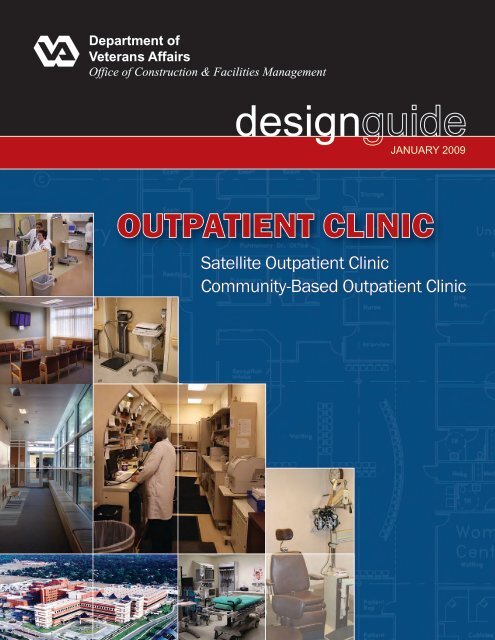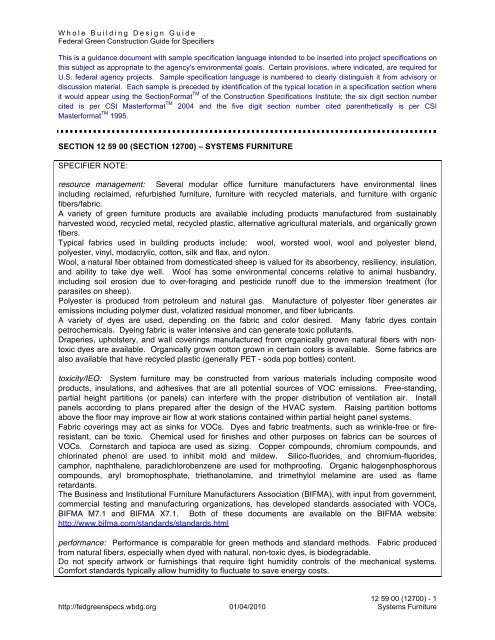Unified Facilities Criteria UFC Whole Building Design Guide
Table Of Content

They provide shelter, encourage productivity, embody our culture, and certainly play an important part in life on the planet. Buildings today are life support systems, communication and data terminals, centers of education, justice, community, and so much more. They are incredibly expensive to build and maintain and must constantly be adjusted to function effectively over their life cycle. The Installation Facilities Standards (IFS) program is part of the Air Force Corporate Facilities Standards (AFCFS) program; and assists bases in implementing and maintaining facilities standards as appropriate for efficient operations within the respective climate region. The Whole Building Design Guide - WBDG () is one of the largest web-based portals providing government and industry practitioners with one-stop access to up-to-date information on a wide range of building-related guidance, criteria and technology from a 'whole buildings' perspective. Through a systematic analysis of these interdependencies, and leveraging whole building design strategies to achieve multiple benefits and synergies, a much more efficient and cost-effective building can be produced.
Finding innovative solutions for the built environment
Questions or interpretations pertaining to these documents or situations should be referred to the Contracting Officer. That task is accomplished by the WBDG Resource Pages which are written by industry experts explaining strategies, technologies, applications, standards, and emerging issues relevant to the subject along with links to related WBDG pages, external websites, publications, and points of contact. Requests to deviate from any installation facilities standards, that are Unified Facilities Criteria (UFC) requirements, will follow the process outlined in the AFCFS for UFC waivers and exemptions. Established by the United States Congress, NIBS' mission is to serve the public interest by advancing building science and technology to improve the built environment. These members contribute their knowledge and experience to the WBDG and collaborate with industry organizations and subject matter experts to better serve the building community.
U.S. Army Corps of Engineers Headquarters > Missions > Sustainability > Building Resilience - U.S. Army Corps of Engineers
U.S. Army Corps of Engineers Headquarters > Missions > Sustainability > Building Resilience.
Posted: Wed, 23 May 2018 05:36:56 GMT [source]
Industry development and diversification
Their interrelationships and interdependencies with all building systems are also understood, evaluated, appropriately applied, and coordinated concurrently from the planning and programming phase all the way through operations and maintenance. A high-performance building cannot be achieved unless the integrated design approach is employed. High-Performance Buildings are energy efficient, have limited environmental impact, operate with the lowest possible life-cycle costs, and have a positive effect on building occupants. There are a number of additional ways and tools to achieve high-performance buildings, such as through the implementation of a life-cycle cost analysis, integrated design processes, integrated energy solutions for the building envelope, and building commissioning. The "integrated design approach" asks all the members of the building stakeholder community, the technical planning, design, and construction team to look at the project objectives, building materials, systems, and assemblies from many different perspectives.
Specifications
For example, the choice of a mechanical system might impact the quality of the air in the building, the ease of maintenance, global climate change, operating costs, fuel choice, and whether the windows of a building are operable. In turn, the size of the mechanical system will depend on factors such as, the type of lighting and controls used, how much natural daylight is brought in, how the space is organized, the facility's operating hours, and the local microclimate. At the same time, these same materials and systems choices may have an impact on the aesthetics, accessibility, and security of the project. A successful Whole Building Design is a solution that is greater than the sum of its parts. Questions, comments, suggestions and recommended changes for guide specifications should be submitted as a Criteria Change Request (CCR). CCRs are not appropriate when they pertain to a specific project solicitation, request for proposal, or after a project award.
Safety is also paramount in buildings with security-related expenditures, one of the fastest rising expenses. There is a great opportunity to reduce these impacts and costs through whole building design. Multiple links between various sections of the WBDG and the Internet allow you to easily access all relevant online information related to a topic, including design tools, federal mandates, and government and non-government standards. At the bottom-most level of the site, browse in-depth technical summaries, called Resource Pages, written by industry experts. For more information, see the Building Commissioning section on the Whole Building Design Guide site. NIBS brings together labor and consumer interests, government representatives, regulatory agencies, and members of the building industry to identify and resolve problems and potential issues in the built environment.

The Integrated Design Approach
The WBDG is unique as it represents a collaborative effort among not only government agency subject matter experts but also those from private sector companies, non-profit organizations, and educational institutions all contributing their knowledge and experience to better serve the building community. Should you have any questions or comments on the WBDG, please feel free to contact our team at At their best, they connect us with the past and represent the greatest legacy for the future.
INDUSTRYEVENTS
As the world of buildings continues to change and grow in complexity, additional programs and information will have an impact on the entire design, planning, and construction community. Among them is Building Information Modeling (BIM) software that is a continued trend in computer-aided design. BIM also aids in the process of integrating the various design teams' work, furthering encouraging and demanding an integrated team process. BIM supports continuous monitoring and management to operate and optimize a project throughout its life cycle. To create a successful high-performance building, an interactive approach to the design process is also required. It means all the stakeholders—everyone involved in the planning, design, use, construction, operation, and maintenance of the facility—must fully understand the issues and concerns of all the other parties and interact closely throughout all phases of the project.

Whole Building Design encompasses all of these issues and programs and is an essential way of approaching building projects. Understanding Whole Building Design concepts will enable you to think and practice in an integrated fashion to meet the demands of today's as well as tomorrow's high-performance building projects. Energy Information Administration illustrates that buildings are responsible for 40% of greenhouse gas emissions annually. Of those total emissions, building operations are responsible for 27% annually, while building and infrastructure materials and construction (typically referred to as embodied carbon) are responsible for an additional 13% annually. A few of the many building materials are responsible for 23% of total global emissions. Seventy-six percent of all electricity generated by U.S. power plants goes to supply the building sector1 and buildings often contribute to health problems such as asthma and allergies due to poor indoor environmental quality.
Though unification of all DOD criteria is the ultimate goal, there are instances when a particular document may not apply to all services, or some documents may have not been fully revised to reflect all service requirements before being issued in the system. Development of the WBDG is a collaborative effort among federal agencies, private sector companies, nonprofit organizations, and educational institutions. The WBDG is the only web-based portal to provide one-stop information on a wide range of building-related guidance, criteria, and technology. List Supplementary Documents in Appendix G of the IFS following the process outlined in the IFS-Operators Manual (IFS-OM).
WBDG is a gateway to up-to-date information on integrated 'whole building' design techniques and technologies. The goal of 'Whole Building' Design is to create a successful high-performance building by applying an integrated design and team approach to the project during the planning and programming phases. Each design objective may be significantly important or unique in any project, yet a truly successful one is where project goals are identified early on and held in proper balance during the design process.
Members of NIBS are on the forefront of understanding how building science and social equity are related. We champion a diverse, equitable, and inclusive industry workforce that matches our communities. Click the 'Title', 'Date' or 'Change Date' heading to sort by ascending or descending order. Narrow the list by selecting a 'Series' option from the dropdown or view archived or inactive documents by selecting from the 'Status' dropdown and clicking 'Apply'.
Questions or interpretations pertaining to these documents or situation should be referred to the Contracting Officer. Refer to the DOD Engineering Criteria Status Report for the list of UFCs that were formerly Agency-specific documents. UFCs that have been unified for use by all participating agencies have no alphabetical letter at the end of the document number. UFCs that are agency-specific have an alphabetical letter (or letters) at the end of the document.
ESG has continued to grow exponentially as government, businesses, and consumers have become more conscious of the need to address how actions and operations affect society and the environment. Narrow the list by selecting a 'Division' option from the drop-down or view archived documents by selecting from the 'Status' drop-down and clicking 'Apply'. All NASA-specific UFGS sections (40) have been removed from the UFGS Master, though some UFGS sections may still include a NASA section reference.
A document that has a letter "A" indicates USACE, an "N" indicates NAVFAC and an "F" indicates AFCEC. The use of Building Automation Systems (BAS) supports the efficient and effective access, control, monitoring, and management of connected building systems in an integrated manner. The use of BAS allows for greater visibility and control over these building elements, saves time and resources, and offers greater comfort and control over spaces. Points of contact and procedures for the development and maintenance of UFGS documents are prescribed in the latest edition of MIL-STD-3007. Obtaining a permit and inspections for construction on your home is required by law and provides important documentation in the event you sell or refinance the property.
The Energy Independence and Security Act (EISA) of 2007 further established a new and aggressive plan for achieving energy independence in our nation's building stock by the year 2030. The Act requires that federal buildings (new and renovations) achieve fossil fuel-generated energy consumption reductions on the order of 55 percent in the year 2010 to 100 percent by 2030. The Act also requires that sustainable design principles be applied to siting, design, and construction. The commissioning process is an emerging and growing industry where the entire commissioning team, including design, construction and operations, needs to communicate and understand their functions to maximize the results of the project. This understanding that commissioning is not an event but a process that extends from project start through design, construction and operation benefits all team members. The commissioning industry needs to provide information and training to enhance the process as it has done in this WBDG revision.
The final NASA UFGS Master is available on the WBDG at NASA UFGS Master Specifications. Army Corps of Engineers (USACE), the Naval Facilities Engineering Systems Command (NAVFAC), and the Air Force Civil Engineer Center (HQ AFCEC). Refer to the Installation Development Plan (IDP) for facilities reuse opportunities and infill projects for infrastructure, sites and facilities.
Comments
Post a Comment